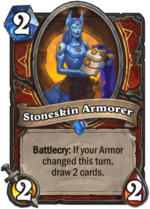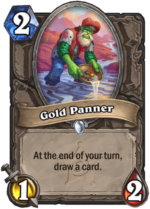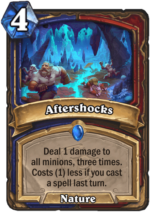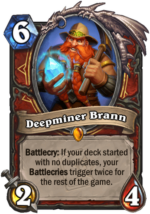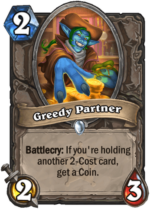Mulligans
General Mulligans
Generally, a removal card (wide, preferably) or a draw engine is optimal for the starting hand. This deck has two weaknesses: it can get steamrolled by aggro without removal and it can get out-valued by other Reno decks that build their endgame faster.
Aggro Mulligans
Always keep a wide removal piece when facing aggro decks, particularly Even Shaman, Aggro Priest and Pirate Rogue. You'll almost always trigger Aftershocks for 2 as you have plenty of spells to sling here.
Control Mulligans
Always go for draw against slower decks. You want to build your finishers - and get to them - as quickly as possible.
Summary
Take Wild format Even Warrior and inject with Highlander steroids. With the addition of Deepminer Brann , Reno Warrior is on the cusp of viability as it allows normally strong Battlecries to give even higher value. This particular flavor leans heavier into control, using Blademaster Okani to help lock out the opponent and Boomboss Tho'grun for major deck disruption which can kill opponents who generate value over the course of the game – like other Reno players, for example.
The deck’s biggest strength is in killing bots and greedy aggro decks but easily holds up to other Reno decks with the right piloting. Using Genn Greymane reduces your Hero Power cost to 1, making Armor generation ludicrously easy, allowing you to build a strong defense that many bots will struggle to overcome. Faster combo decks like Quest Warlock are currently its biggest weakness.
Gears of The (Armor-Printing) Machine
Cards in this deck fall into one of the following “buckets” and how you play them will depend of where you are in the game:
- Armor Generation – Cards for buffing armor total which can later be used as a finisher after an Odin drop. There are many cards in here that do this along with another effect. Remember your Armor can essentially cancel an opponent’s offense, so don’t be afraid to use Armor to power through a turn if you have a good play coming soon. And after Odyn, any of these cards can help get you to lethal attack damage.
- Board Clears and Removal – There are several cards here for dealing with wide boards, the biggest MVP being Shield Shatter due to the fact it can often be played for free and Aftershocks being a good recent upgrade with the Badlands miniset. Note that Bladestorm can be great against single targets if you empty the board first. Of course, Reno, Lone Ranger is here as well.
- Draw Engines – Cards to get you to finishers or to set up future draws. These cards help build value and get you to the pieces you need. You always want one at least one in your opening hand. Remember that you can often draw answers to problems when you have no answers in hand.
- Tide Turners – Cards that change the tide of the game when played. This can include high tech cards like the sideboard buddy E.T.C., Band Manager, the classic flex of Zephrys the Great or of course, the Armor-is-now-Attack effect of Odyn, Prime Designate. Note that these are all Battlecries, meaning that, aside from Odyn, the effects double if played post-Brann.
Piloting Vs. Aggro

Always keep removal in your mulligan when facing aggro. You certainly want a “wide” removal, which is most of what is in this deck anyways. Easy clears like Aftershocks are wanted here (and it almost always drops to reduced cost anyways) and don’t underestimate Igneous Lavagorger as it can both get you Armor and put up a thick body that your opponent is usually wasting value on. If you Dredge Shield Shatter in this manner, you get the card next turn for free if they don’t hit you.
When you have a clear, mulligan for a draw engine piece too. The new totem Needlerock Totem is an easy keep in most situations as its value and armor generation on turn 2. Gold Panner is another good choice that can also be traded into smaller minions but Stoneskin Armorer is almost always an instant-keep as it can payoff as soon as turn 3.
If you have either Drywhisker Armorer in hand or Frozen Buckler along with a Shield Shatter, keep it as you’ll be able to cast it for free. Be stingy about using clears though – try to get the most minions eliminated as you can. Every clear drains your opponent’s resources and we want them slowed down so much that our long-term strategy rolls them over. Don’t underestimate Provoke – remember that 0-attack totems die quickly when forced to attack a 2/2 or 2/3 and 0 mana makes it very flexible. It also is Tradeable, so you don’t have to sit on it in the wrong situation.
Lorekeeper Polkelt is seems like a good keep when on coin, as you can drop him turn 3 and have your Shield Shatter – your second-best removal card – online by turn 4. But this can also be a trap. It makes your deck go from highest-cost to lowest-cost so this can shove a lot of your armor generation to the bottom of the deck. This will often leave you with a hand full of big cards while your opponent is rebuilding. However, Polkelt can get you to your finisher quickly and has an absolutely nuts interaction with Boomboss Tho'grun.
You likely may not even need a finisher should you hold off against, say, an Even Shaman. Usually against such greedy (often bot-piloted) aggro, two or three clears drains your opponents’ resources enough that they are often climbing back from board and hand disadvantage. This deck has a draw engine and plenty of ways to get answers. This deck also has a lot of bigger drops later in the game. Captain Galvangar rarely is less than 9 attack from hand (12 from hand post-Brann!) and a double-Battlecry Zephrys the Great can cause more headaches later.
Piloting vs. Control and Combo

Against slower decks, like other Reno decks or decks that take a while to build a lethal finish, your goal is to outrun your opponent and get your finisher online quickly. Race to drop Brann or Reno if you can so you build greater value before your opponent does and save board clears for dealing with larger threats coming your way. Against these decks you can develop a sense of false confidence; watching your opponent do nothing for 2 or 3 turns can make you feel that you’re going to steamroll the match. Then a big impossible combo comes down and you find yourself struggling to respond. Always assume worse is coming. Get your finishers online, your armor up and pummel the opponent down before they can recover.
Be careful about chasing value too fast however, as you can find yourself with a hand full of clears with no enemies to waste them on. Every now and then, you may have to burn removal just to avoid a full hand and accidentally burning a Tide Turner. Use draw to get a full hand then respond accordingly.
Dropping Deepminer Brann as fast as possible, provided you don’t have a nasty board to deal with, makes all your cards much better. Greedy Partner becomes a Mana Biscuit – essentially free. Iron Juggernaut instills lethal damage into your opponent’s deck. But the best double-up is Boomboss Tho'grun. Should you double this up, you get to destroy SIX cards in your opponent’s deck, six in their hands and SIX of their creatures. That’s half their deck. Note: these cards cost six and can undo your Highlander bonuses. This is where Polkelt comes in.
If you drop Lorekeeper Polkelt after Tho’Grun, it sorts the deck to where you can perform a massive TNT obliteration in a single turn, as the deck sorting lumps all the TNT together. You’ll often destroy something good and may even get a Concede from the opponent if you hit the right thing. This is why you want to wait until LATE in the game to drop Boomboss Tho'grun so it doesn’t conflict with your Highlander effects. But even better is the Astalor Bloodsworn interaction with Brann. You can get Astalor’s final form and do 28 damage from hand once turn 10 hits.
Your best win condition is still Odyn, Prime Designate of course. Remember to use Armor buffs when needed. Drywhisker Armorer‘s effect also doubles after Brann. If you’ve played Odyn and Brann and drop this against a full board, it’s 28 DAMAGE and 28 ARMOR. It’s pretty nuts.
Problems With Even Warrior
Even Warrior has a few big enemies currently: Quest Shaman and Reno Druid are the two biggest problems for this deck, particularly the former. You can get enough Armor to absorb the damage of a Warlock’s completed Demon Seed Questline, but against their empty deck, defeat is often an inevitability. Quest Warlock is often too fast for this deck.
Reno and Dragon Druid, with their current combos of Eonar and cloning said Eonar can simply put up far too much for a Warrior to deal with. This matchup is a bit more dependent on draw and often can leave a Druid vulnerable to face attacks. Draw can often be with you though – as some Druids will hyperfocus on the ramping versus value building or a win condition.
Sideboard for ETC
The sideboard is pretty pricey dust-wise, but each card serves a purpose. Bulwark of Azzinoth is essentially the Warrior’s Solid Alibi and can lock out wide-damage for at least a turn. Rokara, the Valorous can be 15 Points of attack damage and 10 Armor post-Odyn, though with all the Armor generation, you can often use it as removal to swing a big creature back at your opponent. The card you’ll likely reach for most is Lord Barov – he can clear any board, even untargetable minions and cards like Man the Cannons, Provoke and Bash can clear a board cast alongside him for 5 mana or less. If you go for one Legendary in this trio, make it the master Barov.
Other options here can be more control pieces. E.T.C., Band Manager can allow you cheat in Odd-cost cards as they aren’t considered part of the deck if they are in his sideboard. So you can get creative here depending on where you are in the Ladder. Need more removal? Snag Brawl, the O.G. Warrior board clear. You could also slot weapon removal here as well, alternatively.






























/rating_1_off.png)
/rating_2_off.png)


